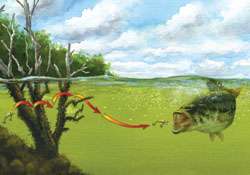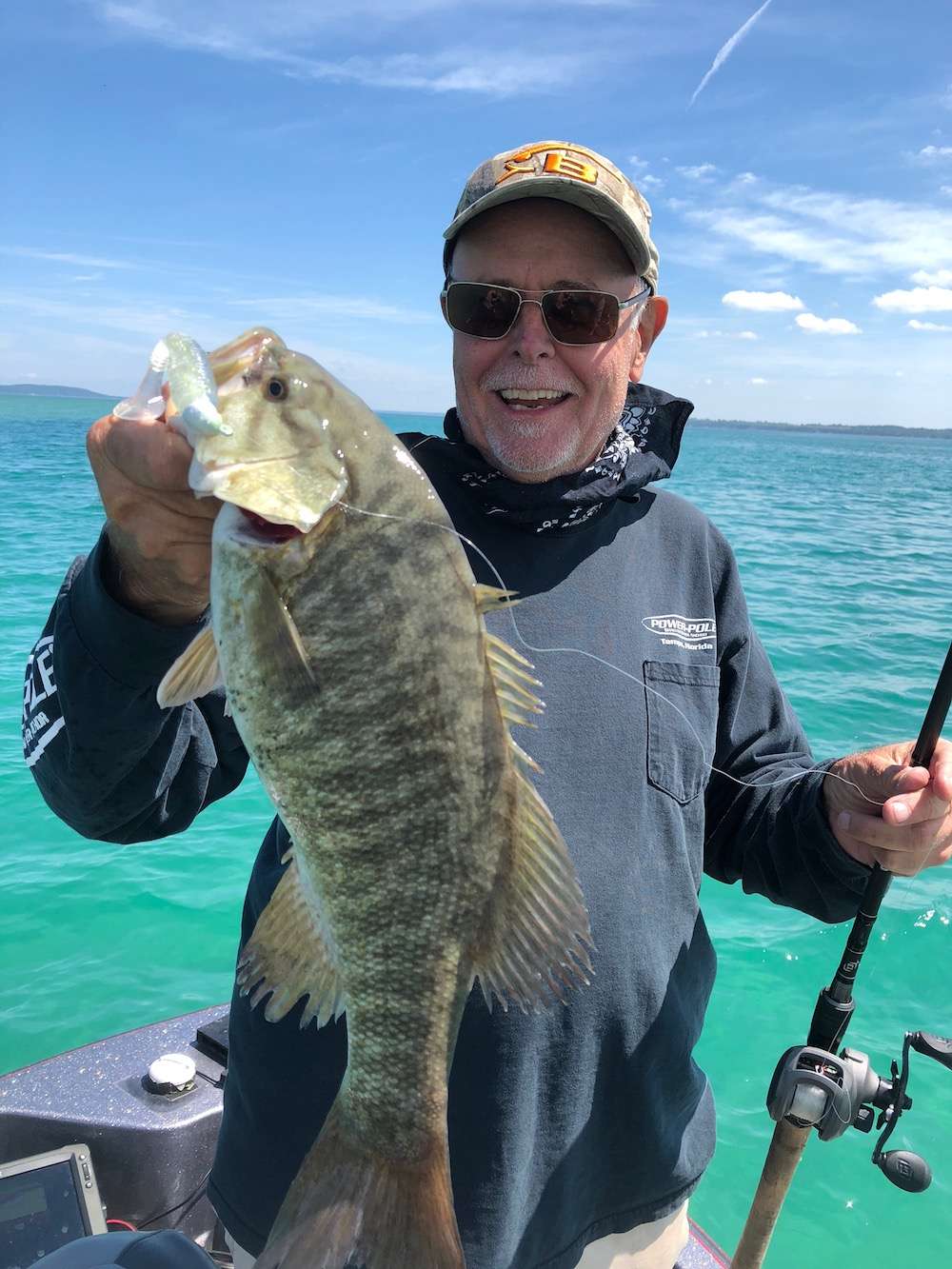
Turn back the clock to the early ’70s. The hottest lures on the BASS Tournament Trail were hand-carved wood crankbaits like the Bagley Balsa B, fat-bodied plugs with short diving lips that triggered hellacious reaction strikes from lunker bass when rooted around shallow wood cover. Then the ’80s arrived, and with the new decade came a different bass fishing craze: deep cranking, popularized by pro anglers Paul Elias and David Fritts. Suddenly all those shallow running crankbaits we’d been using were regulated to the bottom trays of our tackleboxes as we bassmasters stocked up on long-billed plugs capable of diving to depths of 20 feet or more.
But in bass fishing, what goes around comes around. Now shallow cranking is back with a vengeance on the tournament scene as pro anglers crank their way to the bank with short-billed plugs reminiscent of those ’70s classics. “Shallow crankbaits are the new spinnerbaits,” one pro said, referring to the ability of short-billed plugs to trigger strikes around shallow cover. “Of course, I wouldn’t want you to print that ’cause I’ve got a spinnerbait sponsor, too!”
Bassmaster queried two Elite Series crankmeisters for their take on the shallow crankin’ craze, and asked them to share some inside tips on fishing these retro plugs. What follows will have you scouring the depths of your tacklebox for those shallow diving relics from bass fishing’s past.
THE ORIGINAL POWER BAITS
“Shallow diving crankbaits are the original power baits,” claimed Florida pro Bernie Schulz. “Unlike shaky head worms, also currently in vogue on the Elite Series trail, there’s nothing ‘finesse’ about a shallow crank.” Schultz believes the key to the efficiency of these plugs is their short, often squared-off diving lip, designed to deflect the lure off hard objects. “You can cast one of these plugs into a submerged tree without worrying about it hanging up. It’ll root down the trunk and careen off a limb like a frightened baitfish. These plugs provide anglers with plenty of positive feedback because they’re fun to fish and get lots of bites.”
“I almost always reach for a short-billed crankbait over a spinnerbait in lakes with abundant shallow wood cover,” Oklahoma pro Jeff Kriet indicated. “Today, many lakes have been spinnerbaited to death by local anglers. When I’m pre-fishing prior to a tournament, I’ll often see scores of local anglers pounding the banks with spinnerbaits, but very few throwing shallow cranks. I suspect most amateur anglers are afraid of throwing a $7 to $17 plug with two treble hooks into the middle of a brushpile — they don’t understand how well these baits come through cover.” Shallow crankbaits cover the same depth zone as a spinnerbait, but present a totally different look to the bass, Kriet explained. “They capture the jerky, erratic movements of live bluegill or crawfish, which are more common bass forage in shallow water than shad.”
The term “square bill” has been bandied about so much in the bass fishing media lately that many anglers use it to refer to any shallow running crankbait. “Not every shallow crankbait has a square bill,” Kriet pointed out. “Some have a slightly rounded lip, others a coffin-shaped bill. Personally, I think the shape of the bill has been given too much credit for the ability of these baits to come through snaggy cover. What really makes them resistant to hang-ups is their extreme buoyancy. If they didn’t float up at rest, they’d be hung up constantly, regardless of the shape of their lips.”
The aggressive crash-and-burn style of retrieving short-billed crankbaits favored by pro anglers has led to the nicknames “kamikaze crankbaits” and “four-wheel drive plugs.”
“I fish them hard, literally grinding them into the cover,” Schultz said. “I try to scrape bark and bust twigs off submerged wood when I fish ’em. When one of these plugs comes careening into a bass lair out of nowhere, I guarantee it’ll provoke a serious reaction strike. Bass don’t stop to think about it; they just grab it instinctively.”
Some of the more popular shallow cranks currently making waves on the Elite Series tour include the Bandit 200 Series, Bass Pro XPS Shallow Crank, Bomber Model B, Lucky Craft RC 1.5, Mann’s C-4 Elite, Norman Fat Boy, Rapala DT Fat 3, Spro Little John and Strike King Pro-Model Series 1 (all available at Bass Pro Shops; 800-BASS PRO or www.basspro.com). Schultz helped design Rapala’s latest entry in the genre: “The DT Fat 3 is a full-bodied balsa lure that moves a lot of water, making it especially effective in stained and murky lakes. It plows through brush and deflects nicely off stumps and trees, provoking savage reaction strikes.
I used to rotate between several shallow runners before this plug came out; now it’s the only one I need — I’ve caught some monster bass on it!”
Kriet favors the Lucky Craft RC 1.5. “This is one of the most exciting crankbaits you’ll ever fish,” he promised.
“It’s a great plug for bassmasters who have never used shallow cranks before because it gives you a tremendous sense of confidence about attacking shallow cover. If you grew up listening to your dad warning you not to cast his favorite crankbait into a sunken tree, this bait will get you over that fear in a hurry.” The 1.5, like most premium Japanese lures, is expensive, Kriet acknowledges ($16 at Bass Pro Shops). “Yet unlike deep diving crankbaits, you run very little risk of losing it because it only runs 3 to 4 feet deep. Plus, you can fish it on heavy line without compromising its action and castability; so if it does hang up, just rear back and jerk it loose.
Although the 1.5 is a fairly small lure, it weighs half an ounce, and you can throw it half a block on 20-pound mono.”
PRESENTATION TACTICS
“Shallow crankbaits should be viewed as saturation lures more than search lures,” Schultz suggested. “They’re great for making multiple casts to wood or rock cover. Just as you’d make repeated presentations to a submerged tree with a jig, just one cast into cover with a shallow crankbait won’t cut it. You need to make several presentations from different angles, especially during frontal conditions when bass are likely to be holding tight to cover.” Schultz recalled one BASS tournament where he spotted an isolated log in 3 feet of water: “I made nine casts to the cover with a DT Fat 3, then on my 10th cast, I caught a 5-pound bass. The uncanny ability of these lures to root through gnarly cover means you can use them to dissect a piece of cover and goad the fish hiding there into biting.”
Fishing these baits around and through shallow cover demands tackle with a combination of accuracy and winching power. Schultz uses a 6 1/2-foot medium-heavy baitcasting rod and a 6:1 reel, while Kriet favors a 7-foot medium-heavy rod and an ultra-slow 5:1 reel. Both spool up with 15- to 20-pound abrasion-resistant mono (more buoyant than fluorocarbon, yet with significantly more stretch than braid). “You need a rod with the backbone to power a big fish out of thick cover,” Kriet emphasized. He described his shallow crankbait retrieve thusly: “I’ll cast the lure to the target, crank the reel handle fast so the plug careens into the cover, then stop reeling so it floats up a few inches. Then I’ll use my rod, not the reel handle, to move the bait. I’ll pull the rod upward or to the side, lower it while reeling up slack, then pull the rod again. I’ll also use the rod to steer the lure where I want it to go, moving it to the left or right so I can direct the plug into the juncture of a tree trunk and outcropping limbs, around and through the root system of a stump and other key bass-holding spots. I’ll also use the rod to direct the lure away from potential hang-ups.”
“When casting a shallow crankbait to submerged wood cover, I’ll first determine the shape and size of the object by standing and scanning the water through polarized sunglasses, then position my boat so the lure has the maximum amount of contact with the object during the retrieve,” Schultz explained. “If I’m fishing an old laydown tree, one with most of its branches busted off, I’ll root the lure down the trunk and bang it into the stubs of the branches. If it’s a newer tree, one with most of its branches remaining, I’ll run it all the way down the trunk, and then reposition my boat so I’m casting sideways and running the bait down each of the branches.”
Schultz finds the bass he catches when crankin’ shallow tend to run big — “most of them are 3 pounds on up,” he said. They’re smart, too: “These fish know every inch of the cover they’re in and will use this awareness to their advantage when you hook them. They’ll often retreat back under a log or bolt into a nearby brushpile instead of running for open water. That’s where a powerful rod and heavy line come in handy. You’ll need stout tackle to handle the pigs you’ll catch on these plugs.”
MINUS METHODS
Need to go even shallower with your crankbait presentation? Tie on a “minus” plug like a Bandit Footloose, Bass Pro Nitro Super Shallow, Bomber Square A, Mann’s Baby 1-Minus or Norman Fat Boy. These chubby crankbaits have a nearly vertical bill that keeps them just beneath the surface and causes them to trail a wake behind them that can trigger vicious strikes.
Elite Series pros Bernie Schultz and Jeff Kriet are true believers in these extreme crankbaits. “They’re awesome over submerged grass and in shallow, muddy water,” Schultz said. “They run less than a foot deep and really push a lot of water. I’ll pitch a minus plug beneath overhanging tree limbs and under boat docks in spring. It’s a scary sight when a big bass boils up on one of these plugs!”
“These crankbaits are like ATVs — they’ll crawl right over logs and even plow through hydrilla beds growing just beneath the surface,” Kriet added. “They look like a bluegill or gizzard shad trying to shoot out of the shallows. When the water heats up and algae starts growing on foam flotation beneath docks, root one of these plugs parallel to the dock so it scrapes the foam. I’ve caught some hawgs on this pattern in late spring.”





